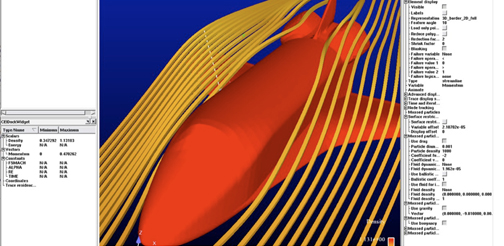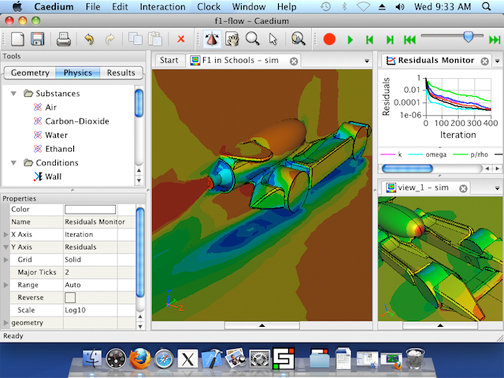Latest News
March 16, 2010


At Macworld 2010 (Moscone Center, San Francisco, California), amidst a sea of iPod skins and audiovisual gadgets, it was all too easy to overlook the lone analysis software developer CEI, right across the aisle from The New York Times. While the respected newspaper was vociferously peddling subscriptions of its digital edition (to be delivered on Apple’s newly launched iPad), CEI demonstrated volume rendering, a new feature now available in its EnSight CFD 2.0 software.
EnSight is described as a “visualization solution for your structural analysis problems, including thermal, vibration, acoustic, and mechanical ... a complete post-processing and visualization product for CFD (computational fluid dynamics), FEA (finite element analysis), FSI (fluid-structure interaction), and engineering data.”
Commercial versions are available in Lite, CFD, Standard, and Gold editions (for a comparison of features, study this chart from CEI). According to the company’s blog, Ensight CFD 2.0 and later versions will be made available in native Mac Cocoa graphical user interface (”A Native Cocoa Mac GUI? Really?” Dec. 4, 2009). This paves the way for CEI’s other products (Lite, Standard, and Gold) currently on X11 (X Window System) to follow suit eventually. Newer versions running natively in Cocoa environment are expected to make better use of Mac OS features.
Along with the new version, the company is releasing a free trial version of EnSight with some limitations. For example, the free version won’t read all file formats, and produces results with a watermark. Volume rendering, however, is available in both the free version and the paid version.
A few weeks after Macworld wrapped up, Symscape, which declares “affordable computer-aided engineering software” as its mission, released Caedium v2.1, the first version with Mac support. Previous versions support Windows and Linux; the latest version adds Mac OS X 10.5 (Leopard) and 10.6 (Snow Leopard) to the list.
The Mac Appeal
Darin McKinnis, CEI’s VP or marketing, said, “The appeal of the Mac platform is partially based on the fact that it offers the combination of a large commercial software library and the good technical underpinnings in the kernel. The commercial software library includes MS Office ... Adobe products ... and Apple applications ... The UNIX environment with shells, X11 (X Window System), etc. makes Linux/Unix appealing to the technical development community.
“Whereas with Windows, it’s more difficult to replicate that Unix/Linux environment. So if customers are demanding Unix or Linux as an option, there will not be that much difficulty also in supporting the Mac ... a segment of the market will be looking for that. Some of this also seems to be driven by the academic markets need for laptops and mobility—engineering and scientific academics are much more likely to use Macs than the typical desktop bound worker
“Another appeal is the platform’s strengths in consistency of applications written for it. Since printing, fonts, PDF creation, and other mainstays of modern computing are part of the built-in experience of using a Mac, it’s much easier to adopt new Mac applications for your workflow. This also makes it easier to develop applications on the Mac. And features like CoverFlow, Xgrid, etc. make it easier to make applications that are intuitive and engaging for the customer.”
Newton’s Apple in Research and Academia
“One advantage the Mac has over the Windows,” noted Richard Smith from Symscape, “is the relatively stable and limited range of machine/software specs, which makes for an easier software porting and testing cycle ... Caedium’s architecture was carefully designed to be cross-platform right from its initial beginnings. The main concerns for a cross-platform product are the GUI and the 3D visualization ... Also the Mac has a strong following in academia, which is an important market for Caedium.”
CEI’s McKinnis said his firm started supporting Mac in 2003 because of the release of OS X in 2000. According to him, “That finally gave Apple the robust Unix/Linux underpinning that seemed to really drive a lot of support. We also had the good fortune to hire a young developer who had a passion for the Mac ... [Furthermore,] we had long supported Unix and Linux and we were starting to get requests from customers in the academic and government CAE market asking for a Mac version.”
McKinnis may have been personally responsible for the development of Mac-supported Caedium, because he “graciously donated a Mac [to Symscape] for porting,” recalled Smith. Similar products available for Mac include Tecplot (for CFD post-processing) and Pointwise (for meshing and grid).
One research organization that once placed a bet on the Mac platform for analysis was NASA Langley Research Center, which developed a tetrahedral unstructured software system, known by the abbreviation TetrUSS. According to its creators, the software is “a time-tested computational aerodynamic capability servicing the configuration aerodynamic needs of NASA’s airframe and exploration programs.”
It was named NASA Software of the Year in 1996 and 2004. It also grabbed the Best Apple Design Award for Scientific Computing Solution in 2004. But the staleness of the product’s home page suggests R&D resources once devoted to the software may have been diverted elsewhere. Site log indicates it hasn’t been updated since August 2006.
Recently, at SolidWorks World 2010, SolidWorks made waves (perhaps more than it intended to) by revealing R&D efforts in progress to explore Mac support. But contradictory statements from company officials make it nearly impossible to assess SolidWorks’ true commitment to the Mac platform. (Read “SolidWorks: Exploring Mac OS But No Timetable For Delivery,” Feb. 23, 2010.)
Most high-end analysis and simulation software product—such as those from MSC Software, NEi, and cd-adapco—remain almost exclusively on Windows. But renewed interest in Mac, as illustrated by the releases of CEI’s EnSight CFD 2.0 and Symscape’s Caedium, suggests at least some developers think the platform is worth a second look.
Subscribe to our FREE magazine, FREE email newsletters or both!
Latest News
About the Author
Kenneth Wong is Digital Engineering’s resident blogger and senior editor. Email him at [email protected] or share your thoughts on this article at digitaleng.news/facebook.
Follow DE





